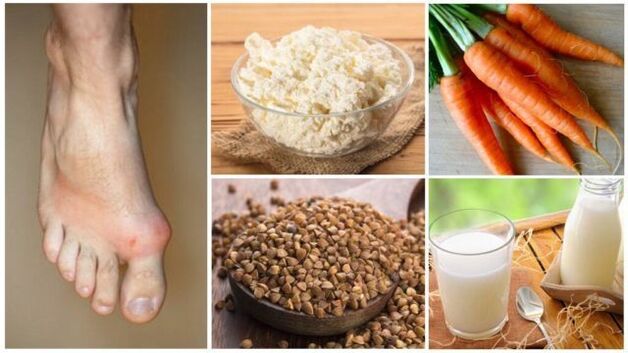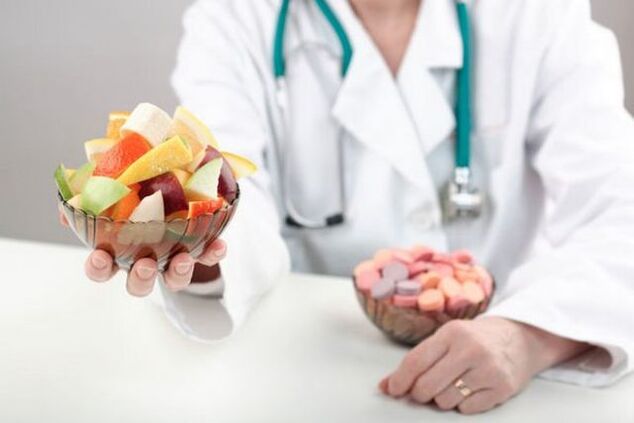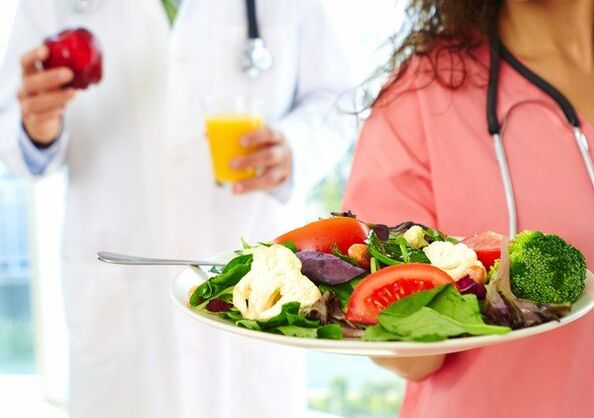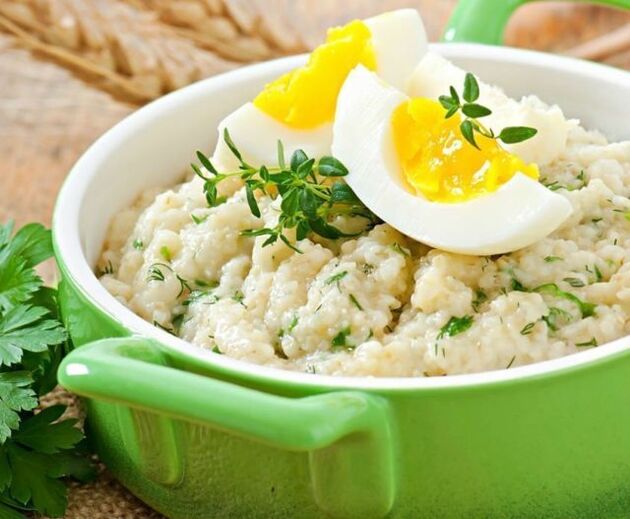
Malnutrition, combined with poor digestion, can lead to the development of gout. The disease develops when the level of uric acid in the blood exceeds the allowable limit (above 420 μmol / l for men, 350 μmol / l for women). Metabolic Disorders Salts of this acid settle on the surfaces of the intestines, blood vessels, and joints, damaging vital organs.
Over time, the disease becomes chronic and recurrent. In the acute period, patients experience excruciating pain at the site of localization of the pathological process. Diet for gout leads to normalization of uric acid levels and reduction of disease.
Why do you need a diet for gout?
An important task of therapeutic measures is to reduce the nature and frequency of the disease. This can be achieved by reducing the amount of uric acid in the body.
The development of gout attacks is due to:
- consumption of foods high in purines;
- metabolic disorders.
Dietary optimization allows you to begin the proper processes of absorption and excretion of substances. Therapeutic measures aimed at eliminating the causes of the disease are closely linked with compliance with certain dietary restrictions. With the right diet, you can slow down the progression of the disease.

The foods that make up a person's daily diet should include foods that are high in nutrients.
Nutritional therapy for gout aims to reduce the symptoms and eliminate the food components that cause them. The foods we eat every day have a great impact on our overall health and respond to the chemical processes that take place in the human body throughout life.
What not to eat with gout?
Based on their research, scientists have identified a list of foods that directly affect the initial development of the disease and its further development.
The list of things to eat for gout includes:
- smoked bitter cheese and cheese product;
- cholesterol-rich meat and bone products (pulp of young animals and pigs, hooves, calves);
- meat and bone fats, ears;
- high-fat fish (sardines, sprats);
- pickled vegetables, pickled fruits (cabbage, watermelon, cucumber, apple);
- hot and cold smoked products;
- beans (peas, beans, soybeans, lentils);
- greens containing oxalic acid (spinach leaves, crunchy, rhubarb root);
- hot spices, sauces;
- certain types of vegetable crops (Brussels sprouts and cauliflower, radishes);
- internal organs of animals (kidneys, liver, lungs, heart, brain) obtained during the slaughter of corpses;
- oatmeal;
- confectionery oil products;
- alcohol of any percentage;
- fruits (grapes, raspberries, figs);
- hot, spicy and essential spices (bay leaves, horseradish, chili-pepper);
- animal fats and fat products (lard, margarine, lard);
- canned meat, fish and fruits and vegetables.

If the food is unbalanced or if there are a lot of fatty, spicy or heavy foods for the digestive system, the person's metabolism may be disturbed.
List of products recommended for restriction:
- coffee, strong tea;
- May;
- apricots;
- night vegetables (eggplant, tomatoes, peppers);
- table salt, granulated sugar;
- mushrooms (only in remission).
These foods should be removed from the diet for a long time to alleviate the attack and maintain remission.
What can you eat with gout?
The list of foods recommended for patients with this disease:
- dietary meat products (rabbit, poultry, lean beef);
- skinny white fish (pike, pike, cod, pollock);
- bran and rye bread;
- chicken eggs (excluding yolks);
- cereals (rice, wheat, buckwheat, millet, pearl barley);
- fresh vegetables (beets, carrots, cucumbers, cabbage, potatoes);
- seasonal fruits, berries (watermelons, melons, apricots, strawberries, peaches, cherries, blackberries, green apples);
- pasta;
- walnut kernels (hazelnuts, walnuts, cedar);
- herbal teas and decoctions (Dubrovnik, basil, cat);
- fermented dairy products, cottage cheese;
- freshly squeezed juices, fruit drinks, compotes;
- boiled tomatoes;
- spices (turmeric, fennel, basil);
- vegetable oils (olive, canola).

Nutritional therapy for gout helps the patient to quickly get rid of unpleasant and painful symptoms at home.
In limited quantities, natural honey is beneficial for gout. This product is suitable as a sugar substitute.
Honey has many beneficial properties:
- immunostimulation;
- antioxidant;
- improvement of metabolic processes;
- bactericidal.
Do not abuse bee products during the peak season. People with this disease should eat foods rich in vitamins, trace elements and amino acids. A useful supplement is pharmaceutical fish oil for gout.
General food rules
Removing some forbidden foods from the regular menu does not guarantee immediate relief. In addition, the list of products varies depending on the stage and severity of the disease. Thus, nutrition for exacerbated gout involves maintaining more severe restrictions than during remission.

There are general rules for patients with this disease, and it is important to follow them in diet therapy:
- Eat small meals several times a day (5-6 times a day). Starvation leads to an increase in urinary acetone. And this can exacerbate the disease.
- Chew food well, do not overeat.
- Limit the amount of table salt used in cooking (up to 5 grams per day). Salt has the property of retaining fluid in the tissues, which in turn leads to the deposition of uric acid salts.
- Optimizing fluid balance in the body. To do this, it is recommended to drink at least 2 liters per day.
- Organize fasting days. Vegetables, milk and fruits (except those prohibited).
- Keep restrictions for a long time, as a short-term treatment diet is ineffective.
People with severe metabolic disorders and diabetes and gout should not include containers that cause a jump in uric acid and insulin levels. The gout and diabetes diet is designed to reduce these rates to prevent exacerbations and complications.
How to cook properly?
The list of food is not limited. You need to choose the right cooking method when cooking.

There are no special requirements for the preparation of products other than meat processing.
Baking is allowed in the following ways:
- for couples;
- baking;
- power off;
- boiling;
- calm down.
Against baking:
- frying;
- smoking;
- salting and pickling;
- fermentation.
Do not eat old, burnt food. The temperature of the food consumed should be optimal for food and should not exceed 40 degrees. Food should not be rough or harsh. If necessary, various dishes can be chopped with a mixer.
Effective diet: menu for each day
In terms of the composition of essential components, medical protein (protein-carbohydrate-fat balance), calories, vitamins, trace elements, amino acids must meet the physiological needs of patients.

Approximate diet for gout and high uric acid:
1 day
First breakfast: baked cod, mashed potatoes, black bread, white cabbage salad, seasoned with sour cream, a cup of weak coffee with saccharin.
Second breakfast: a casserole of cheese, boiled eggs, breadcrumbs, tea.
Lunch: vegetarian soup with roasted roots and potatoes, beef, buckwheat porridge, fresh cucumber, 1 apple.
Dinner: carrot cutlets, pasta, milk, biscuits.
At night: 200 ml of kefir.
Day 2
First breakfast: boiled white cabbage, 1 boiled egg, black bread, cappuccino.
Second breakfast: cappuccino, biscuit cookies.
Lunch: lean borscht, bran bread, baked poultry fillets, baked rice, fruit jelly.
For dinner: baked potatoes with vegetables, vegetable casserole, bread with butter, a glass of soup.
At night: 250 ml of boiled milk.

Day 3
First breakfast: vegetable salad (white cabbage, carrots, apples), weak coffee.
Second breakfast: cottage cheese with sour cream, rosehip soup.
Lunch: barley soup with sour cream, steamed cutlet, mashed potatoes, fruit jelly, whole grain bread.
Dinner: carrot cutlets with fruit, a pan of cereals, a glass of milk.
Before going to bed: steamed plums.
Day 4
First breakfast: carrots with sour cream, wheat porridge, a glass of green tea.
Second breakfast: dried fruit cutlets, compote, biscuits.
Lunch: Milk noodles, chicken with pumpkin and potatoes, fruit jelly, black bread.
For dinner: oven-baked cheesecakes, carrot and apple cutlets, a cup of tea with lemon.
At night: 200 ml of warm milk.
Day 5
First breakfast: buckwheat porridge, green tea.
Second breakfast: a glass of fresh carrots.
For lunch: vegetable rice soup with sour cream, boiled beef pulp, beet caviar, honey and basil tincture, rye bread.
For dinner: pumpkin casserole with sour cream, a glass of weak tea, crackers.
Before going to bed: pour rose hips with honey.
6 days
First breakfast: chicken protein omelet, baked beets, white bread, a glass of weak coffee.
Second breakfast: zucchini casserole, fruit compote.
Lunch: vegetarian barley soup, baked potatoes, baked meatballs, jelly, rye bread.
Dinner: rice cooked in milk, weak tea.
Before going to bed: a glass of yogurt.
The standard diet is developed by a doctor. There are a variety of combined dietary options. Diet number 6 is common for gout. Its main principle is the removal of foods and utensils with a high purine content, the addition of alkaline beverages to the diet and gentle processing during cooking. An independent menu with restrictions on the amount and nature of food can lead to long-term illness.














































































